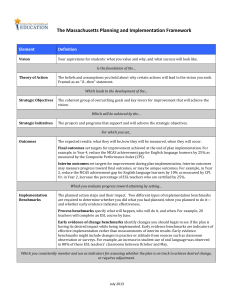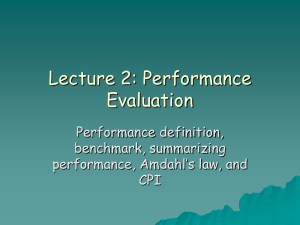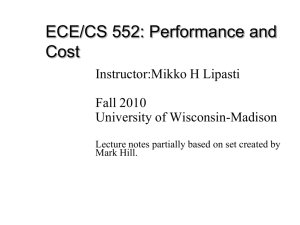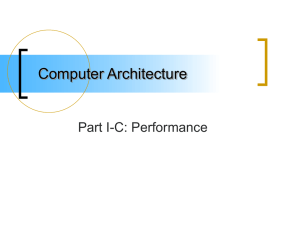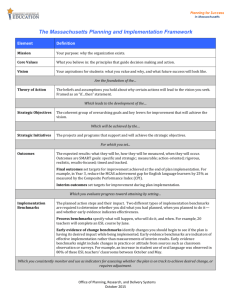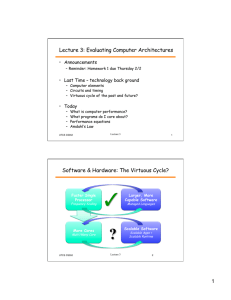Performance Analysis Systems I Topics Measuring performance of systems
advertisement
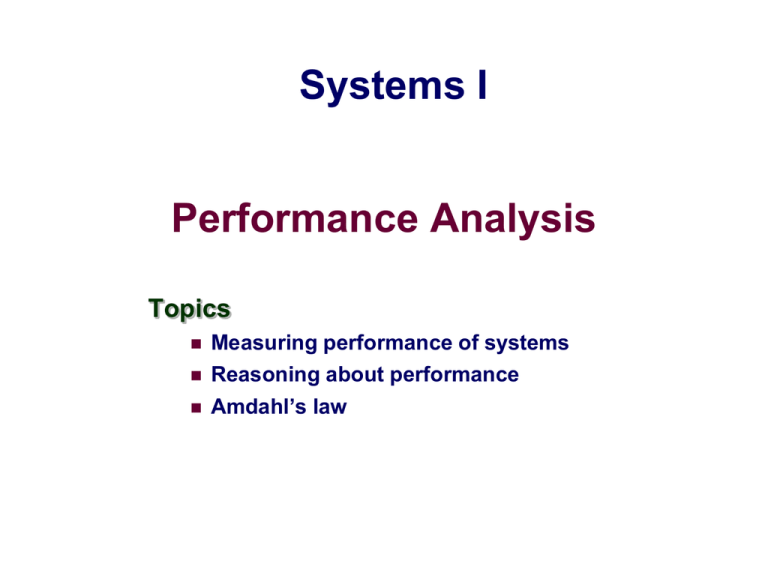
Systems I Performance Analysis Topics Measuring performance of systems Reasoning about performance Amdahl’s law Evaluation Tools Benchmarks, traces, & mixes macrobenchmarks & suites application execution time microbenchmarks measure one aspect of performance traces replay recorded accesses » cache, branch, register MOVE BR LOAD STORE ALU 39% 20% 20% 10% 11% LD 5EA3 ST 31FF …. LD 1EA2 …. Simulation at many levels ISA, cycle accurate, RTL, gate, circuit trade fidelity for simulation rate Area and delay estimation Analysis instructions, throughput, Amdahl’s law e.g., queuing theory 2 Metrics of Evaluation Level of design performance metric Examples Applications perspective Time to run task (Response Time) Tasks run per second (Throughput) Systems perspective Millions of instructions per second (MIPS) Millions of FP operations per second (MFLOPS) Bus/network bandwidth: megabytes per second Function Units: cycles per instruction (CPI) Fundamental elements (transistors, wires, pins): clock rate 3 Basis of Evaluation Pros Cons • representative Actual Target Workload • portable • widely used • improvements useful in reality Full Application Benchmarks • easy to run, early in design cycle • identify peak capability and potential bottlenecks Slide courtesy of D. Patterson Small “Kernel” Benchmarks Microbenchmarks • very specific • non-portable • difficult to run, or measure • hard to identify cause •less representative • easy to “fool” • “peak” may be a long way from application performance 4 Some Warnings about Benchmarks Benchmarks measure the whole system application compiler operating system architecture implementation Popular benchmarks typically reflect yesterday’s programs Benchmark timings are sensitive alignment in cache location of data on disk values of data Danger of inbreeding or positive feedback what about the programs people are running today? need to design for tomorrow’s problems if you make an operation fast (slow) it will be used more (less) often therefore you make it faster (slower) » and so on, and so on… the optimized NOP 5 Know what you are measuring! Compare apples to apples Example Wall clock execution time: User CPU time System CPU time I/O wait time Idle time (multitasking, I/O) csh> time latex lecture2.tex csh> 0.68u 0.05s 0:01.60 45.6% user elapsed system % CPU time 6 Two notions of “performance” Plane DC to Paris Speed Passengers Throughput (pmph) Boeing 747 6.5 hours 610 mph 470 286,700 Concorde 3 hours 1350 mph 132 178,200 Which has higher performance? ° Time to do the task (Execution Time) – execution time, response time, latency ° Tasks per day, hour, week, sec, ns. .. (Performance) – throughput, bandwidth Response time and throughput often are in opposition Slide courtesy of D. Patterson 7 Brief History of Benchmarking Early days (1960s) Single instruction execution time Average instruction time [Gibson 1970] “Real” Applications (late 80snow) SPEC Desktop Pure MIPS (1/AIT) Scientific Java Media Simple programs(early 70s) Parallel Synthetic benchmarks (Whetstone, etc.) Kernels (Livermore Loops) etc. TPC Transaction Processing Relative Performance (late 70s) VAX 11/780 1-MIPS but was it? MFLOPs Graphics 3D-Mark Real games (Assassin’s Creed, Call of Duty, Flight Simulator, etc.) 8 SPEC: Standard Performance Evaluation Corporation (www.spec.org) System Performance and Evaluation Cooperative HP, DEC, Mips, Sun Portable O/S and high level languages Spec89 Spec92 Spec95 Spec2000 SPEC2006.... Categories CPU (most popular) JVM, JBB SpecWeb - web server performance SFS - file server performance Benchmarks change with the times and technology Elimination of Matrix 300 Compiler restrictions 9 How to Compromise a Benchmark 800 Spec89 Performance Ratio 700 compiled enhanced 600 500 400 300 200 100 0 gcc spice nasa7 matrix300 fpppp 10 The compiler reorganized the code! Change the memory system performance Matrix multiply cache blocking You will see this later in “performance programming” After Before 11 Spec2006 Suite 12 Integer benchmarks (C/C++) compression C compiler Perl interpreter Database Chess Bioinformatics Characteristics 17 FP applications (Fortran/C) Shallow water model 3D graphics Quantum chromodynamics Computer vision Speech recognition Computationally intensive Little I/O Relatively small code size Variable data set sizes 12 Improving Performance: Fundamentals Suppose we have a machine with two instructions Instruction A executes in 100 cycles Instruction B executes in 2 cycles We want better performance…. Which instruction do we improve? 13 CPU Performance Equation 3 components to execution time: CPU time Seconds Instructio ns Cycles Seconds Program Program Instructio n Cycle Factors affecting CPU execution time: Program Compiler Inst. Set Organization MicroArch Technology Inst. Count X X X CPI (X) X X X Clock Rate (X) X X X • Consider all three elements when optimizing • Workloads change! 14 Cycles Per Instruction (CPI) Depends on the instruction CPIi Execution time of instructio n i Clock Rate Average cycles per instruction n CPI CPIi Fi i 1 Example: Op ALU Load Store Branch Freq 50% 20% 10% 20% ICi where Fi ICtot Cycles CPI(i) %time 1 0.5 33% 2 0.4 27% 2 0.2 13% 2 0.4 27% CPI(total) 1.5 15 Amdahl’s Law How much performance could you get if you could speed up some part of your program? Performance improvements depend on: how good is enhancement how often is it used Speedup due to enhancement E (fraction p sped up by factor S): Speedup(E) ExTime w/out E Perf w/ E ExTime w/ E Perf w/out E p ExTimenew ExTimeold 1 p S ExTimeold 1 Speedup( E ) ExTimenew 1 p p S 16 Amdahl’s Law: Example FP instructions improved by 2x But….only 10% of instructions are FP 0.1 ExTimenew ExTimeold 0.9 0.95 ExTimeold 2 Speeduptotal Speedup bounded by 1 1.053 0.95 1 fraction of time not enhanced 17 Amdahl’s Law: Example 2 • Parallelize (vectorize) some portion of your program • Make it 100x faster? • How much faster does the whole program get? Speedup vs. Vector Fraction 100 Speedup p T1 T0 (1 p ) S 90 80 70 60 50 40 30 20 10 0 0 0.1 0.2 0.3 0.4 0.5 0.6 0.7 0.8 0.9 1 Fraction of code vectorizable 18 Amdahl’s Law: Summary message Make the Common Case fast Examples: All instructions require instruction fetch, only fraction require data optimize instruction access first – Data locality (spatial, temporal), small memories faster storage hierarchy: most frequent accesses to small, local memory 19 Is Speed the Last Word in Performance? Depends on the application! Cost Not just processor, but other components (ie. memory) Power consumption Trade power for performance in many applications Capacity Many database applications are I/O bound and disk bandwidth is the precious commodity Throughput (a form of speed) An individual program isn’t faster, but many more programs can be completed per unit time Example: Google search (processes many, many searches simultaneously) 20
